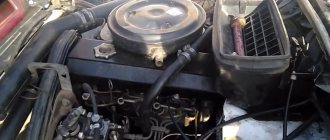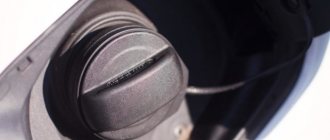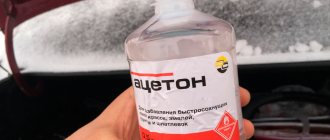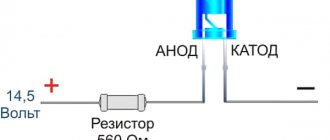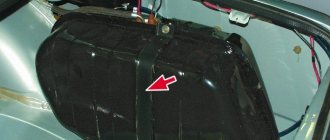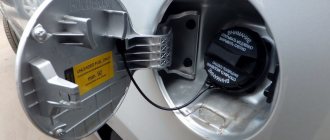How to remove the tank on Niva 2121
We continue the epic of improving the car!
As practice has shown (Grid grids, Trip to the village of Borok and how we treated Niva), something is wrong with the fuel system. The signs of these “not okay” are the following: - the smell of gasoline in the cabin; — you have to refuel by hand and control the pressure so that it is very small; — when filling under the filler neck, fuel drips in the area of the right rear wheel; — on potholes the car tries to stall. All this led to the fact that one fine sunny day I decided to work on the gas tank and the entire fuel system. Before going deep, I tried to study this issue for the presence of certain spare parts in this system, which most often fail, which is why the fragrance of 92 gasoline is possible, and just in case, I went to the store for fuel hoses (according to the catalog number is 2121-1101079-20). In the store they looked at me like I was an idiot and said that they didn’t import this, they don’t import it and it’s unlikely that I will ever import it. I stood, looked at the shelves of various spare parts that I didn’t need at the moment, scratched my little head and decided to buy tubes for the windshield injectors. They pour all sorts of chemicals on the glass, maybe they can withstand gasoline. The job needs to be done, but there are no tubes. I bought 10m for the footage. If it remains, it will be useful in the future. Before removing the tank, I threw a piece of the purchased tube into a bottle of gasoline for testing. I took everything out of the trunk, removed the back seat and put it outside. I removed the right side panel trim and the rubber gas tank pipe. I unhooked the supply and return pipes and pulled the gas tank out into the sunlight. There was not much gasoline in it, I didn’t refuel on purpose, I got there with the lamp on.
Then I prepared a container where I would drain the gasoline from the tank and also prepared a five-liter bottle with the purest 92 m. To make it easier, I removed the fuel level sensor. I looked inside the tank - there was a hole there... Let's start washing. We take the tank in our hands, feet shoulder-width apart, and with circular movements, first clockwise, then counterclockwise, we begin to drive *evenly* around the tank. This is a delicate matter, you have to feel it; when you start to see a funnel, you need to sharply turn the tank upside down into the drain container we have prepared. Wait until everything drains from it, pour in fresh 92 from five and start the fitness procedure again. Calculate the number of repetitions yourself based on the cleanliness of the fuel tank. It turned out that in four approaches I drained everything from the tank.
I poured it into another five-piece that I had prepared. In color, what I merged resembled (may...) yellow rubbish with pieces of silicone, some kind of stones and other foreign bodies. Where does the sealant come from?
I went to look at the filling pipe. He took it out of the car and began to twirl it in his hands. Mom is dear, the air hole is sealed with sealant. I picked everything out, put it away, cleaned it.
I put it in its place. I tore off the old pipes from the gas tank.
The overflow tubes were made of oak and cut off in the area of the separator. Self-tapping screws are screwed into the cut ends (as if plugged), and the ends are inserted from the right into the area of the rear right fender. When the tank was full, gasoline drained through these tubes and through these plugs and flowed out just in the area of the right wheel.
I removed and inspected the separator. I had it made of plastic and the proboscis on it were cracked. I had to go to the store again for a new separator, a new hose that goes to the filler neck (to the gas tank cap), new clamps and a new fuel level sensor. I bought everything and came back.
I looked at how the tube, lowered into a bottle of gasoline, was doing there. I took it out, twirled it in my hands, it didn’t seem to soften. I decided to install it anyway. I measured the required length, cut it and installed it on the tank. Next I installed a new fuel level sensor. The next step was to install the fuel tank on the car.
Everything is simple here, as usual. The tank was installed, the pipe hose was put in place and the clamps were tightened. First, I put all the hoses on the separator. I did it carefully so as not to damage the proboscis. Then he put the separator in place and screwed it on. We return the trim, seat and all the junk to the car in reverse order. I also replaced the fuel filter with a new one. Next, we fill the remaining clean gasoline from the fiver into the tank and start the car. Beauty - it works)) At this point, washing the tank is completed.
PS Refueling. Kirov-Sovetsk-Borok car behavior on potholes, smell of gasoline (review of flushing the gas tank)
Some time after the work had been done, we again went to Sovetsk. On leaving the city we filled up the tank full. My joy knew no bounds) Having removed all the sealant, I cleared the way for air. Now he has somewhere to go when gasoline enters the tank and begins to displace it from there. Accordingly, now there is no need to control the pressure so that it is very small. You also have to refuel by hand, but only because if you don’t lift the gun, it rests against the grate. Now you can refuel very quickly, as if there was no grate. We filled the tank full and drove off. The smell of gasoline in the cabin no longer haunted us. There was no fuel dripping in the wheel area. So we got to the city of Sovetsk, to the village of Borok. I will also say that the car now runs smoothly over bumps and does not try to stall, which means there is enough fuel for it. That's all, friends!
Removing the fuel tank
There must be a minimum amount of fuel in the tank.
Disconnect the negative cable from the battery. Remove the fuel tank compartment cover (see Removing an electric fuel pump with a fuel level sensor). Remove the right side upholstery (see Removing interior upholstery). We disconnect the electric fuel pump from the wiring harness and pipelines (see Removing the electric fuel pump with a fuel level sensor). Unscrew and remove the fuel tank cap.
Use a Phillips screwdriver to loosen the clamp.
. and remove the plastic tank ventilation hose from the right fitting.
Similarly, disconnect the tank ventilation hose from the left fitting.
Use a Phillips screwdriver to loosen the clamp on the fuel tank hose and filler pipe.
. and remove the hose from the tank fitting.
Using pliers, loosen the clamp of the filler pipe hose.
Remove the filler pipe with hoses and the rubber O-ring.
Using a 13mm socket, unscrew the two rear mounting bolts for the fuel tank.
. and two bolts for the front mounting of the tank to the cross member.
Autonomous mileage after switching to gas
Autonomous mileage 2121 Niva (4x4) with gas equipment
| Volume | Transfers | Cylinder capacity | Refilling the cylinder | Total autonomous mileage | ||
| Around town | On the road | Mixed | ||||
| 1.6 | Mechanics | 47 l. | ||||
| 1.6 | Mechanics | 47 l. | ||||
| 1.7 | Mechanics | 47 l. | ||||
| 1.7 | Mechanics | 47 l. | ||||
| Price per liter of gas in calculations: CIS - 18.61 ₽. | ||||||
HBO increases the autonomous mileage of the VAZ 2121 Niva 1977...present SUV. doubled. Now there is definitely enough fuel for the longest trips.
Call to ask questions, consult with a specialist or sign up for installation in Moscow (24 hours a day) or write to [email protected]
Certified multi-brand center for installation, maintenance and repair of gas equipment:
Gas Performance Benefits
IN COMBINATION, THESE FACTORS EXTEND THE ENGINE LIFE BY
Gas extends the life of oil and spark plugs and reduces vehicle maintenance costs.
Gas burns a little slower than gasoline, which reduces the load on the piston group and crankshaft, causing the engine to run smoother.
The gas mixes easily with air and fills the cylinders more evenly with a homogeneous mixture, so the engine runs smoother and quieter. The gas mixture burns almost completely, so no carbon deposits form in the pistons, valves and spark plugs.
The octane number of petroleum gas is 103-105, which virtually eliminates detonation of engine parts. This advantage of gas can be especially important for engines with a high compression ratio that consume high-octane (and therefore expensive) gasoline.
The gas does not contain harmful impurities (lead, sulfur), which at the chemical level destroy the combustion chamber parts, catalytic converter and lambda probe.
The gas enters the engine in the vapor phase, so it does not wash away the oil film from the walls and does not dilute the oil in the crankcase.
Savings on fuel are greater than the overpayment on the loan
First payment 0 rub.
Loan term from 1 month
Loan cost 1.6% per month
Loan decision in 15 minutes
Switch to gas and start saving
You will get back the overpaid money for using a two-year loan in the second month of operating the system.
On average, the savings per year when driving on gas is 50,000 rubles.
Save up to 200,000 rubles per year
1 km of mileage on gas is 2 times cheaper than 1 km of mileage on gasoline
Calculate the savings of driving on gas compared to using gasoline
1. Select your car
For example: Peugeot Partner, Citroen Berlingo, Renault Kangoo, VW Caddy
2. Indicate the mileage of your car per year
Having extensive experience in operating gas equipment (this is already the 4th gas-powered car!), I can confidently say that AGTS specialists are the best professionals in converting cars to gas in St. Petersburg. no less than 100 percent. The feeling is super, if you have any doubts, I highly recommend it.
This is the second time I've come here. Hyundai Accent is my second car and, accordingly, my second LPG. Just like the first time, I installed Italian equipment from Lovato. It seems to me that it is the best. At least it’s very easy to set up, which can’t be said about other systems. And stability in operation: the settings are the same as they are. In total, I have been using HBO for 4 years now, and no problems. The most important thing is to regularly visit maintenance and immediately correct errors if something is wrong.
For me, LPG is no longer new - I’ve been driving gas for almost 10 years, and I install it on every new car. I think it’s not worth describing all the delights of the equipment, and a lot of things have already been told without me. I’ll tell you better how the installation of gas equipment in the AGTS went. I made an appointment with the guys a week in advance, arrived at the appointed time, and they were already waiting for me. The box is large and well equipped. Two people are allocated for each car, everything is done quickly and smoothly. I stood there, watching them. It is immediately clear that the team has worked well together. One installs the wiring, the other connects the cylinder. It’s obvious that they know their job here: every car is there – and on the day I arrived, it was sold out. Everyone is busy, there is no unnecessary talk, just business. At this rate, they installed the HBO for me for about two hours, probably, then one worker explained how it works, what is connected to what, etc. That is, in addition to the fact that they quickly installed it, they also gave instructions on how to use it and what to do if something goes wrong. This, it seems to me, is just great for those who are encountering HBO for the first time. And I, an experienced gas driver, was pleased to listen) In general, I recommend it!
The principle of installing gas equipment on a VAZ 2131
The installation of gas equipment is complicated, which is also the main disadvantage of the system - it is the need to allocate additional free space for installing the cylinder itself. It acts as a fuel tank. Standard capacity - 90 l. This cylinder is located in the trunk of a car. Naturally, part of it will have to be sacrificed. Another option is to install only 50 liters, which will take up significantly less space. But it will have to be refueled much more often, especially if the car is primarily operated on gas.
You can also place a cylinder in the VAZ 2131 in the muffler area. But it will also have to be partially reworked and an additional beam added. At the same time, of course, the Niva’s ground clearance will decrease, which will negatively affect the SUV’s cross-country ability on a dirt road. Fortunately, there is more than enough space for such a modification in the VAZ 2131. It differs from the regular Niva in that it has an extended wheelbase of 500 mm and the installation of 2 additional doors.
The basis of the HBO kit is:
- gearbox;
- electric gas supply valve;
- electric valve for switching to gasoline;
- mixer (aka mixer).
The most difficult thing is not the installation of gas equipment, but the choice of the location of certain components. This also entails safety and ease of use. For example, it is better to place the gearbox itself on the left side of the hood on a rigid mount. In this case, when hitting various types of bumps, the engine speed will not drop (due to the deflection of the internal diaphragm). A gas valve will be located nearby. For gasoline - on the other side, at the inlet of the carburetor. All that remains is to choose a place for the mixer. It is better to “embed” it in the area of the stove pipes in the VAZ 2131. True, you will still have to buy a tee. But such a system will work flawlessly throughout the entire period of active operation of the Niva.
Answers (7)
The fuel tank volume of the VAZ Niva 2121 three-door and five-door 2131 is 65 liters.
For those who are especially gifted, I can recommend reading the technical description of the Niva 2121 and other modifications, their tank capacity is 42 liters.
42 liters - tank volume! It can't be 65
VAZ 21312 - (my car...) - has 65 liters.
three-door "shorty" 42 l five-door 2131 "crocodile" 65 l
To refuel and service a domestic VAZ SUV, you need to know the filling capacities of the VAZ 21213 Niva and its modifications, the VAZ 21214. Some numbers need to be known by heart, for example, the capacity of the tank and engine crankcase. The rest should be written down in a notepad, which is stored in the glove compartment of the cabin. And it doesn’t matter that you are not going to do the maintenance of the car yourself, the specialists at the service station may also not know the refueling volumes of your car.
Operating principle
The cooling system of VAZ Niva models does not come into contact with the atmosphere in operating condition, and therefore requires pressure. The coolant is antifreeze with a freezing point of 40 degrees Celsius. The composition of the solution is water and ethylene glycol. The total volume of the cooling circuit is 10.7 liters. Antifreeze can boil after a temperature of +110 degrees Celsius.
The main functional unit in the system is the thermostatic valve, which distributes the coolant flow depending on the engine temperature. The thermostat, controlled by a temperature-sensitive sensor, regulates the direction of movement of antifreeze. A simplified work flow looks like this:
- Before the internal combustion engine warms up to operating temperature (+90 degrees Celsius), the cooler moves along a small circuit (interior heating radiator, thermostat, power plant) using a pump.
- The damper opens towards the large circuit where the radiator is located, at a temperature of + 80 degrees Celsius. Afterwards, virtually the entire cooler moves along a large circuit, mainly cooling through the radiator.
- The small ring is not blocked, but a minimum of antifreeze enters it due to pipes of a smaller diameter.
- In model 2121, the fan is mounted on the axis of the water pump and constantly directs the air flow to the (BC). Cooling fans in Niva 21214 and 2131 are paired with electric drive. They are activated alternately or together using a temperature sensor (switching temperature is about 100 degrees Celsius).
- When heated, excess antifreeze is sent to the expansion tank, increasing the pressure in the system, which reduces the boiling threshold of the coolant.
In summer and during transition periods in models with an injector, the movement of the cooler is limited by a special tap. The Niva Chevrolet model does not have such a blocker, so the heating is turned off by directing the air flow past the heat exchanger.
Transmission
Automatic transmission, Automatic transmission radiator, Valve block, Torque converter, Automatic transmission sensor, Decorative trim, Automatic transmission housing, Automatic transmission bracket, Mechatronics DSG, Automatic transmission pan, Automatic transmission gasket, Automatic transmission cushion, Automatic transmission handle, Automatic transmission oil seal, Automatic transmission solenoid, Automatic transmission thermostat, Brake Automatic transmission tape, Automatic transmission cable, Automatic transmission dipstick, Manual transmission, Oil cooler, Secondary shaft, Manual transmission sensor, Manual transmission housing, Manual transmission bracket (mount), Rocker, Input shaft, Manual transmission cushion, Secondary shaft bearing, Primary bearing shaft, Speedometer drive, Manual transmission gasket, Intermediate bearing, Manual transmission handle, Shift lever, Shaft seal, Manual transmission seal, Synchronizer, Manual transmission cable, Transmission gear, CVT variator, CVT belt
Capacity displacement and “appetites” of the iron horse
All cars could be equipped with the same tanks, if not for the individual level of consumption, because this indicator cannot be ignored. Based on the characteristics declared by the manufacturer or based on personal experience, you can calculate how far you can travel with a full tank of gas. You have to count on your own less and less often, because modern vehicles are equipped with on-board computers that quickly and easily solve this problem.
The volume of the Niva 2131 tank is 65 liters. How long will this displacement last? Depends on conditions. In the city, this model “eats” approximately 11.1 liters, which means it will be possible to travel approximately 660 kilometers. If your speed is 90 km/h, then a hundred will take no more than 9 liters. This means that with 65 liters you will travel at least 700 km. The largest “appetites” are observed in the Niva at a speed of 120 km/h. In this operating mode, the vehicle consumes 12.1 liters per 100 km. And even with this consumption, you can travel more than 500 kilometers.
Installing LPG on a VAZ 2131 is quite simple. But what will this give? First of all, significant fuel savings. The standard engine installed on this model has a volume of almost 1.6 liters and a power of 87 hp. With. Consumption - up to 12 liters per 100 km in country driving mode. With current fuel prices this will be quite expensive. And gas equipment will help fix this. In addition, it remains possible to freely switch the operating mode from gas to gasoline.
First, you can purchase an LPG kit from Milano and place the cylinder in the muffler area. But it will also have to be partially reworked and an additional beam added. At the same time, of course, the Niva’s ground clearance will decrease, which will negatively affect the SUV’s cross-country ability on a dirt road. Fortunately, there is more than enough space for such a modification in the VAZ 2131. It differs from the regular Niva in that it has an extended wheelbase of 500 mm and the installation of 2 additional doors.
The basis of the HBO kit is: - gearbox; — electric gas supply valve; — electric valve for switching to gasoline; - mixer (aka mixer).
The most difficult thing is not the installation of gas equipment, but the choice of the location of certain components. This also entails safety and ease of use. For example, it is better to place the gearbox itself on the left side of the hood on a rigid mount. In this case, when hitting various types of bumps, the engine speed will not drop (due to the deflection of the internal diaphragm). A gas valve will be located nearby. For gasoline - on the other side, at the inlet of the carburetor. All that remains is to choose a place for the mixer. It is better to “embed” it in the area of the stove pipes in the VAZ 2131. True, you will still have to buy a tee. But such a system will work flawlessly throughout the entire period of active operation of the Niva. Installation of a gas cylinder
Costs of 2121 Niva on gas, difference
Propane consumption, savings
| Volume | Transfers | Gas type | Gas consumption by road type | Refueling for 1000 km, mixed mode | ||||
| In the city | On the road | Mixed | Petrol | Gas | Difference | |||
| 1.6 | Mechanics | CIS | 14.3 | 7.7 | 9.9 | 3 087 ₽ | 1 842 ₽ | |
| 1.6 | Mechanics | CIS | 14.3 | 7.7 | 9.9 | 3 368 ₽ | 1 842 ₽ | |
| 1.7 | Mechanics | CIS | 12.1 | 8.8 | 9.9 | 3 368 ₽ | 1 842 ₽ | |
| 1.7 | Mechanics | CIS | 12.1 | 8.8 | 10.5 | 3 259 ₽ | 1 954 ₽ | |
| LPG - liquefied petroleum gas (propane). Gas price in rubles per liter: CIS - 18.61 rubles. | ||||||||
Compressed natural gas is consumed in city mode at the speed of gasoline, and on the highway it is 20% slower. CNG is cheaper than LPG by one and a half to two rubles per liter.
Blocking the differential mechanism
All-wheel drive does not always guarantee a vehicle's ability to pass on bad roads. In most cases this is not enough. It is only in situations where locking and four-wheel drive work together that the vehicle becomes close to an all-terrain vehicle.
And at the same time, you should always remember that differential locking is a mode intended exclusively for difficult driving conditions. With the help of the blocking system, you can drive through places where other cars cannot pass. It is not recommended to use this mode unless necessary in the city. Otherwise the machine may break down.
Fluid for refilling the hydraulic steering system
Table 12
| Material grade | Manufacturer | Regulatory document |
| PENTOSIN CHF11S | Pentiosin Werke AG, Germany | TTM 1.97.0964-2004 |
List of products containing precious metals in LADA 4x4 cars
| Product number | product name | Location of precious metals | Weight in grams | ||
| gold | silver | palladium | |||
| 2115-3801010 | Instrument cluster | In semiconductors | 0,000263 | 0,016414 | |
| 2105-3747010-03 | Turn signal and hazard warning light switch | Gold in semiconductors, silver in contacts | 0,0180561 | 0,0208012 | 0,103 |
| 2105-3709310/-01 | Three lever switch | Coating | 0,1664 | ||
| 2101-3704010-11 | Ignition switch | In contacts | 0,14078 | ||
| 2105-3710010-03/-04 | Hazard switch | In contacts | 0,107 | ||
| 21213-3709607 | Heated rear window switch | In contacts | 0,11517 | ||
| 2113-3709609-10 | Rear fog lamp switch | In contacts | 0,115169 | ||
| 2104-3709612 | Rear window wiper and washer switch | In contacts | 0,403093 | ||
| 2107-3709608-01 | Heater switch | In contacts | 0,265997 | ||
| 21045-3709280 | Fuel heating switch | In contacts | 0,170288 | ||
| 2108-3720010-10/-11/-12 | Brake light switch | In contacts | 0,1681 | ||
| Generator voltage regulator | In semiconductors | 0,0534 | |||
| 2106-3828110 | Water temperature indicator sensor | In contacts | 0,0161637 | ||
| 2105-3747010-02/03 | Relay-breaker for direction indicators and hazard warning lights | Gold in semiconductors, silver in contacts | 0,00021 | 0,0731 | |
| 2105-3747210-12 | High beam relay | In contacts | 0,055 | ||
| 2105-37470-1010-12 | Low beam relay | In contacts | 0,055 | ||
| 2105-3747210-02 | Headlight wiper relay | In contacts | 0,137 | ||
| 2114-3747610 | Rear fog light relay | Gold in semiconductors, silver in contacts | 0,000998 | 0,034935 | |
Gas equipment adjustment
There are quite a few ways to debug HBO, but most of them include the following aspects:
- Compliance of LPG with vehicle standard. Gas equipment on cars with EURO-1,2,3 environmental standards can use any control unit. For the Russian automobile market, the production of such vehicles ended in 2011. The only additional condition for reliable operation of the VAZ-2106, 2110, 21213, 21214 brands can be the use of high-quality radio components. And for models with the EURO-4.5 standard (VAZ-2131, 2123, 2121 and Largus after 2011), it must be equipped with a special program that takes into account road conditions and the fuel used.
- Settings options. When entering data, a difficulty arises with the type of fuel injection of a particular car brand.
VAZ-2131 belongs to cars with pairwise parallel fuel injection
Thus, vehicles with sequential fuel injection include VAZ-21213, 21214, 2123, 2110, 2106, 2121, Largus and Chevrolet, and vehicles with pairwise parallel injection include VAZ-2131.
- Connecting a diagnostic scanner for a gasoline unit. The main goal of debugging gas equipment is to bring the parameters of the engine running on gas to the data obtained from running the engine on gasoline. And this information can only be obtained using a gasoline block scanner. So, for brands 21213 and 21214 there is a slight difference in engine power, so the settings will differ. The deviation in the amount of fuel supplied during fuel correction is displayed as a percentage; a shift from 0 occurs when the injection time changes from the reference values. When debugging, enter the correct coefficient into the system and observe how the car reacts to adjustments.
Other liquids and fuels and lubricants
Every car enthusiast should know by heart the maximum fuel capacity of his car. The fuel tank of the VAZ 21213 has a capacity of 42 liters, including reserve. The reserve refers to the amount of fuel remaining in the tank after the yellow warning light on the instrument panel turns on. The reserve amount is at least 5 liters. The car must be fueled with gasoline whose octane number is in the range of 91-93.
The car has a number of refueling tanks that the owner must monitor during operation:
- brake system with expansion tank, total capacity - 0.515 l;
- hydraulic clutch drive with expansion tank - 0.2 l;
- 2 plastic tanks with a volume of 2 liters each contain a supply of windshield and rear window washer fluid.
Technical characteristics of engines on Niva
Since the domestic car has been so advertised, let's take a look at the technical characteristics of the Niva 2121 internal combustion engine. They are all recorded in the table.
| Parameter | Meaning |
| Power | 87 horses |
| Engine capacity in liters | 1,7 |
| Ecoclass | Different models have different classes. For example, 21214-41 – Euro 3. 21214-30 – Euro 4. |
| Torque | 129 Nm |
| Number of cylinders | 4 |
| Number of valves | 8 |
| Max speed | 142 mph |
| Cylinder diameter in mm | 82 |
| Piston stroke in mm | 80 |
| Nutrition | Distributed |
| BC | Cast iron |
| cylinder head | Aluminum alloy |
| Lifetime of the power unit | 150,000 km |
| Fuel for operation | AI 95 |
| Cylinder operation | 1-3-4-2 |
| Tact | 4 |
Attention! The closer the Niva engine is produced to the year in which it lives, the higher the environmental class.
The Niva's fuel consumption is as low as all small cars. Car owners often change their gasoline engine to a diesel engine for their Niva Chevrolet. Let's take a look at the advantages obtained by installing this engine and the negative aspects that the owner has to face.
Chevrolet Niva
Chevrolet Niva is a Russian all-wheel drive SUV jointly produced by AvtoVAZ and the American General Motors. It went into mass production in 2002, and in 2009 it underwent a noticeable restyling. So far, only the first generation of this off-road vehicle can be seen on sale, although for many years there has been talk of launching a second one.
Fuel consumption for the Chevrolet Niva differs depending on the engine modification; below is the consumption in mixed mode for each of the existing modifications:
Chevrolet Niva 2002-2009:
- 1.7 l, 80 l. With. – 10.9 l/100 km;
- 1.8 l, 125 l. With. – 10-10.1 l/100 km.
All modifications run on AI-92 gasoline.
Chevrolet Niva 2009 – our days (restyling):
- 1.7 l, 80 l. With. (AI-92) – 10.2 l/100 km;
- 1.7 l, 80 l. With. (Regular gasoline: AI-92, AI-95) - 10.8 l/100 km.
What is the fuel consumption of the Chevrolet Niva in different road conditions? According to the passport data, in the urban cycle the normal consumption is 14.1 liters per “hundred”, and on a free highway – only 8.8 liters. But according to reviews from owners, it is unlikely to meet 8.8 liters on the highway: more realistic figures are 9-10 liters of gasoline.
Differential lock on Niva (self-block): bringing the car to perfection
Today we will look at products that can qualitatively improve the Niva transmission. There are a huge variety of them on the market. We will try to clearly and intelligibly answer the question - which self-block is better to install on the Niva.
Content
- What are we dealing with?
- Coefficient, preload and other nuances
- Types of locks on Niva Limited slip self-block (LSD)
- Forced blocking
- How to decide what to install?
What are we dealing with?
What is a differential or as it is sometimes abbreviated as “diff”. Why is it needed?! The Latin word “differentia” and the similar English word “different” are translated into Russian almost identically: “difference” or “different”. There is another definition of differential - planetary gear.
The purpose of this element is to transmit the power of the power unit through rotation without losing it on the axle shaft with the wheels attached to them. The differential causes them to rotate at different speeds depending on driving conditions. Inside a turn, the wheel makes much fewer revolutions than one that goes along a long radius. If in place of the “planetary” there was an ordinary solid axle, the probable parasitic circulation of power would guarantee a decrease in control over the car, loss of traction with asphalt, significant wear of the transmission, incredible fuel consumption, etc. The differential “links” the drive of one axle, removes the “parasitic” phenomenon, without loss of power.
An interwheel differential is present in almost all cars. It is usually located on the drive axle. There may be two or more axes to which the planetary gear distributes the incoming power flow.
Coefficient, preload and other nuances
The Niva 2121 is equipped with permanent all-wheel drive, and therefore, in addition to two inter-wheel differentials, it has a third - an inter-axle differential, distributing the moment between the front and rear.
A regular “free” differential is not always enough for a Niva owner. An SUV is bought to drive like a mother-in-law on different terrain and surfaces: dirt, snow, ice, etc. Often a car ends up with two wheels on a grippy surface and the other side on a slippery texture. In such a situation it is easy to “lose” him. Blocking will allow you not to worry about this.
When choosing a block, you need to take into account two important points - blocking coefficient and preload. The first denotes the ratio of torque on the lagging wheel with good grip and on the leading wheel, which has already lost contact with the road. A free differential has a coefficient of 1. For self-locking ones, it is up to five. That is, the lagging wheel will receive 5 times more torque. This parameter is sometimes indicated in %. For worm gears it is determined by the inclination of the teeth, for disk drives it is determined by the configuration of the friction clutches.
And preload is a certain moment of blocking inside the body of the product even before the moment when it may be required. Mostly in modern self-blocks, preload is created by washers. It can be customized to suit almost any driver's requirements. The washers can be replaced as they wear out, and the differential will continue to serve faithfully for many more years. While the teeth of the “worm” and the clutches of the “disc” design wear out sooner or later, the preload decreases.
True, it is important not to “overdo it” here - excessive preload greatly increases the load on the differential itself and increases the wear of all transmission elements.
Types of blocking on Niva
“Native” differentials can be replaced with a self-locking analogue of increased friction or with a device where the “planetary gear” is locked forcibly. For those who want to install a self-block on a Niva themselves, we will try to thoroughly explain the difference between a worm, screw or disk lock. Let’s evaluate each design that works “from the button.”
Limited slip self-block (LSD)
A limited slip differential or limited slip differential is installed on various sports cars. Many companies have been mass-producing such things in Russia for a long time and in large quantities. It initially has limited slip. This thing independently equalizes angular velocities. It essentially serves as a direct transmission, as if the power is transferred to a single “stick” on which two wheels rotate equally. Can also be installed on a Niva 2124 car.
LSDs are distinguished by the response format - from the occurrence of a difference in angular speeds (disc) or when the torque changes (screw).
Disk lock
There are many options for implementing such a lock, but they all have a common principle - the differential here is equipped with two sets of discs. As soon as slipping occurs, the clutches compress and equalize the angular velocities. The discs are similar to automatic transmission clutches. They do not interfere in any way with the civilian operation of the car. The preload here is created by a spring or conical rings.
The SV-PARTS store offers locking for everyday driving on the Niva for axle shafts with 22 or 24 splines:
This makes it possible to use this product even on the good old Niva, produced by AVTOVAZ, or on its “younger” sister – Chevrolet Niva:
Lada 4×4 3D SAMOVAR › Logbook › Additional tank for Niva, 75 l, neck boiled for 2 tanks
In all the BZs, I wrote about such an obligatory moment of Nivka’s preparation as increasing the power reserve.
A native tank of 42 liters with a consumption of 10 l/100 km is absolutely not enough. And if you go off-road with the active use of a low gear or a winch, the consumption can increase to an exorbitant 40 l/hour, the distance traveled during this time is no longer so important. That is, frankly the tank is simply small. I briefly voiced the concept in earlier blog posts when preparing other vehicle systems for the introduction of an additional tank. In particular, when they removed the exhaust to the side, freeing up the rear overhang under the tank. Tasks and goals:
1. Use the rear overhang to install an additional tank.
2. The tank should not interfere with the standard suspension and other devices. 3. Do not reduce departure and approach angles. 4. Have baffles to reduce fuel sloshing. 5. Have a fuel gauge. 6. The tank can be used as the main one, instead of the standard one ( you can make such a shmurdyachyok there,
the seats can be raised), and as an additional one. 7. Both tanks must be refueled from the same place, with the obligatory choice of the tank to be refilled.
The tank is ready:
77 liters, weight 11.4 kg, one partition, 1 mm stainless steel all around. It has a filler tube, atmosphere, 10 mm intake and 6 mm return, UAZ sensor. The tank is made for pumping by an external electric pump into the main tank.
I’ll immediately focus on the pumping system and the UAZ sensor in order to eliminate questions:
1. The pump takes fuel from the additional tank through the intake and its filter, the return is turned off.
2. The pump control button will be in the cabin next to the UAZ display meter. 3. I like the separate UAZ display meter better than the system with switching on the original display meter, since the tank hangs in the rear overhang and I prefer to see in real time how much fuel there is and if the tank is damaged, I will see it immediately. 4. The pump pumps fuel into the neck of the main factory tank. If the latter overflows through the boiled neck, the fuel itself will flow into the additional tank. 5. Through the boiled neck, the tanks communicate by pressure. 6. There is an idea to do steam recovery from the neck, it is the highest.
Source

